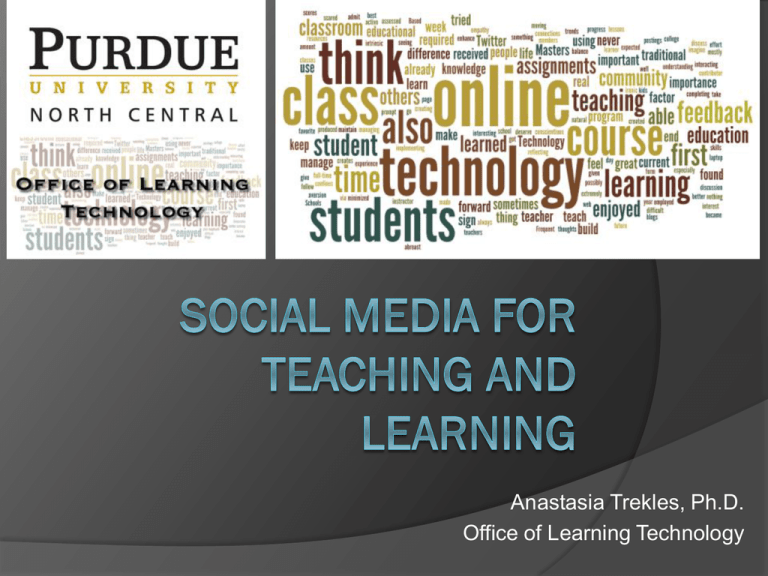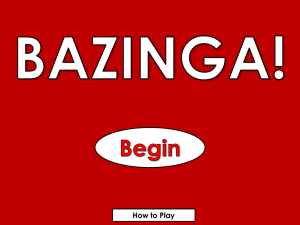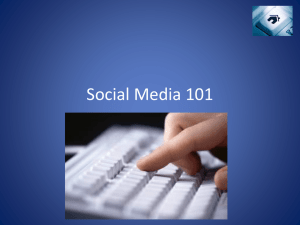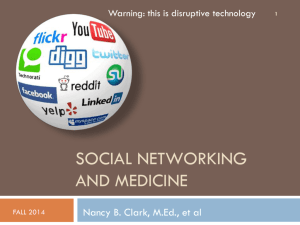Review the slides on social media for teaching and learning
advertisement

Anastasia Trekles, Ph.D. Office of Learning Technology Why Social Media? Social media and Web 2.0 technologies can extend learning into new and exciting areas Web 2.0 can touch every level of Bloom’s Taxonomy, from Remembering to Creating Even better: social media is FREE and easy to access – and usually familiar to students as well See http://edorigami.wikispac es.com/Bloom's+Digital+ Taxonomy Advantages of Social Media Everyone is using it – it’s almost guaranteed to reach its audience Free of cost Naturally creative and intuitive interfaces Enable easy sharing and disseminating of information 64.4% of faculty use social media for personal reasons 44.7% use it for professional reasons 33.8% use it in their teaching Facebook and YouTube are the most common social media in use by educators Blogs, wikis, LinkedIn, podcasts, and Twitter are used a little less often With social media, students can… Compare and share notes and resources Debate and discuss Contribute more equally Learn from one another Learn from experts and others in the field Get exposed to new ideas, cultures, and languages The Flip Side: Potential Pitfalls Social media is, of course, social by nature! Posts are not always private, although they can be made that way Students (and others) can say and do things we’d rather they didn’t Luckily, severe incidents are quite rare, and easy to avoid Social Media Can Make Learning Fun Post important announcements and actually get them read! Create group projects like collaborative projects, scavenger hunts, and round-robin discussions Allow students to showcase their unique talents and interests through pictures and video Build a community of learners by encouraging students to share and ask each other questions Encourage students to connect in more meaningful, convenient, and personalized ways Facebook Allows for private, members-only groups to be created Also allows for public pages to be created for a class to use for announcements and other one-way postings You don’t have to “friend” your students – that’s a personal choice You can create a “school-only” Facebook account strictly for your class activities About Groups: https://www.facebook.co m/about/groups About Pages: https://www.facebook.co m/about/pages Great infographic on Facebook in college classrooms: http://www.schools.com/ visuals/collegeprofessors-onfacebook.html Twitter Lots of neat discussions can be had in 140 characters or less! Don’t believe it? Check out http://twitter.com/FieldingE ngl102 Keep students engaged and interested with short tidbits, helpful hints, and online resources Use hashtags to keep conversations related and easier to follow About Twitter: https://support.twitter.com Twitter for Teachers: http://www.schrockguide. net/twitter-forteachers.html Ways to use Twitter in academia: http://academhack.outsid ethetext.com/home/2008/ twitter-for-academia/ Twubs – great for following hashtags: http://twubs.com Google+ Google has a large number of socialinfused features, including the popular Hangout tool Also, consider Google Docs as a collaborative tool or an alternative to Office Google Drive (formerly Docs): http://drive.google.co m Hangouts: http://www.google.co m/hangouts Google’s Education page with tutorials and more: http://www.google.co m/edu/teachers/ Pinterest Pinterest as a teaching tool? You bet! Pinterest can take information on any topic and make it visual, userfriendly and easy to categorize and share So many resources are already available – students can easily browse and repin things they find Similar sites include Scoop.it and Learni.st Pinterest Help Center: https://en.help.pinterest. com/home The OLT Pinboard: http://www.pinterest.com /pncolt/technology-tothe-rescue/ How colleges are using Pinterest for education: http://teachthought.com/ social-media/howcolleges-are-usingpinterest-in-education/ YouTube YouTube provides a great platform for students to share and publish as well as learn We all know there is a tremendous amount of valuable content out there – just search and you’ll find something good! Armed with smartphones or other camera devices, students can easily create and upload their own work Great for reviews and study groups, presentations, and group projects YouTube Education University channel: http://www.youtube.com/ch annel/HCScmg5b9x0xQ 10 YouTube Channels to make you smarter: http://mashable.com/2013/ 04/04/youtube-education/ Using online video in the classroom: http://www.edutopia.org/yo utube-educational-videosclassroom What’s integrated into BlackBoard? Blogs – for student thoughts to be shared and commented on Wikis – for fluid student conversations and group document editing Collaboration – “chat room” and whiteboard function similar to Adobe Connect (requires Java) Kaltura – media sharing tool for videos you upload (yours or someone elses) Mashups – integration from YouTube, Slideshare.net, and Flickr available Caveats and Parting Thoughts Social Media can be a terrific tool for learning But, it can be a little “messy” – there’s a lot to negotiate, and a lot to keep up with No tool is perfect, either Requires patience and a willingness to try something different, or think about an old activity in a new way Thanks! Staci: atrekles@pnc.edu Alex: acrisw00@pnc.edu Twitter: @PNCOLT http://pnc.edu/distance for all workshop notes, links, and training needs Resources Overcoming Hurdles to Social Media in Education: http://www.educause.edu/ero/article/overcoming-hurdlessocial-media-education Great blog on social media in higher ed: http://blog.reyjunco.com Social Media resource round-up: http://www.edutopia.org/social-media-education-resources Six ways to use social media in education: http://cit.duke.edu/blog/2012/04/six-ways-to-use-socialmedia-in-education/ Friedman, L.W., Friedman, H.H. (2013). Using social media technologies to enhance online learning. Journal of Educators Online, 10(1). Retrieved from http://www.thejeo.com/Archives/Volume10Number1/Fried man.pdf.











